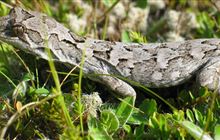Awakopaka skink
Introduction
Awakopaka skink was first discovered in 2014. For years it was not seen again but was finally found in 2019. It is still only known from less than 20 individuals at one small location.Scientific name: Oligosoma awakopaka
New Zealand status: Endemic
Conservation status: Threatened, Nationally Critical
Primary Threats: Unknown, but likely mammalian predators, including mice
Description
Length: Up to 77 mm from nose to the base of its tail.
Awakopaka skink population: Only known from less than 20 individuals from one location.
Food: Invertebrates, fruit, nectar.
The meaning of its name is the “skink that lives in the footprints of mighty glaciers”.
Distribution
These rare lizards are only known from within a few hectares of rugged boulder habitat near the Homer Saddle in Fiordland. In this steep and exposed rocky alpine environment, predators including mice and stoats as well as introduced browsers such as hares, rabbits, chamois and deer are dramatically impacting the balance and health of the ecosystem.
With such a potentially tiny population, a large increase of mice could potentially render the species functionally extinct in a single season.
Challenges
The challenges on the ground in Fiordland have been to establish one of the first attempts at sustained suppression of mice on mainland New Zealand. The team have established a high-density grid of bait stations. This is informed by regular monitoring of the mouse populations across a range of altitudes near the awakopaka skink site. The bait stations are serviced monthly. This is no small feat considering the precarious terrain and the challenges of working in changeable weather conditions.
“We need to intensify our efforts for all predators present where the awakopaka skinks occur” says Dr James Reardon (DOC scientist and herpetologist), “but mice are our biggest concern. Most of the time they’re present in pretty low numbers but the combination of beech and tussock seeding and weather conditions can create plagues easily capable of decimating this skink population.”
What we’re doing to learn more
Our DOC Fiordland lizard team, as part of a collaborative effort by Auckland Zoo and Ngāi Tahu, carefully planned a translocation of “Nationally Critical” awakopaka skinks to captivity during summer 2023/24. This work is in response to a predicted beech masting event where mouse populations were expected to reach very high numbers.
At the same time, the team established high intensity ground-based control in a desperate attempt to mitigate the risk mice pose to this hardly known species.
We’re hopeful that the mouse control will protect this species. But the threats don’t stop at introduced predators. Global warming could have serious consequences too.
“Species like these skinks have particular micro-habitat requirements, like a dependency on high humidity, vegetation communities and their associated invertebrates, and these things are dependent on the alpine snowpack.” says Reardon, “We’re seeing a loss of the permanent snow and that has consequences for the habitat. We have no idea how this might impact skinks.”
How you can help
We are very keen to learn of any sightings of lizards in the alpine zone of South Island mountains – the area above the tree and shrub zones. If you have seen a lizard in the alpine zone, we would like to hear from you. Send us:
- a photo of the lizard
- a photo of the area where you found it
- exact location information.
Send your information to: lizardresearch@doc.govt.nz



